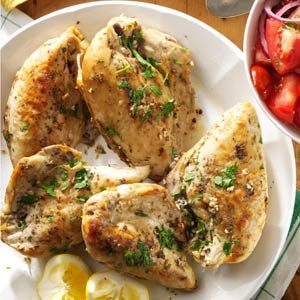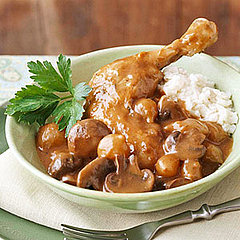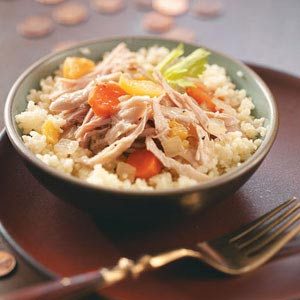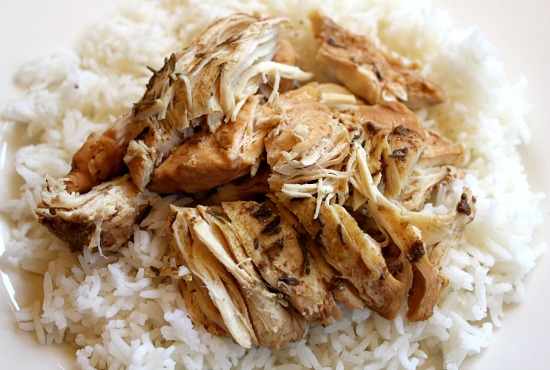Crockpot Chicken Recipes Biography
Source:- Google.com.pk
A slow cooker, also known as a Crock-Pot (a trademark that is sometimes used generically in the US, Canada, Australia and New Zealand), is a countertop electrical cooking appliance that is used for simmering, which requires maintaining a relatively low temperature (compared to other cooking methods such as baking, boiling, and frying),allowing unattended cooking for many hours of pot roast, stews, soups, "boiled" dinners and other suitable dishes, including dips, desserts and beverages. The Naxon Utilities Corporation of Chicago, under the leadership of Irving Naxon, developed the Naxon Beanery All-Purpose Cooker. Naxon was inspired by a story his Jewish grandmother told about how back in her native Lithuanian shtetl, her mother made a stew called cholent, which took several hours to cook in an oven.The Rival Company bought Naxon in 1970 and reintroduced it under the Crock-Pot name in 1971. Slow cookers achieved popularity in the US during the 1970s when many women began to work outside the home. They could start dinner cooking in the morning before going to work and finish preparing the meal in the evening when they came home. In 1974, Rival introduced removable stoneware inserts making the appliance easier to clean. The brand now belongs to Sunbeam Products, a subsidiary of Jarden Corporation. Other brands of this appliance include Hamilton Beach, West Bend Housewares, GE, Magic Chef, Kitchen Aid, Cuisinart, and former American Electric Corporation.A basic slow cooker consists of a lidded round or oval cooking pot made of glazed ceramic or porcelain, surrounded by a housing, usually metal, containing an electric heating element. The lid is often of glass seated in a groove in the pot edge; condensed vapour collects in the groove and provides a low-pressure seal to the atmosphere. The contents of a crock pot are effectively at atmospheric pressure, despite the water vapor generated inside the pot. A crock pot is quite different from a pressure cooker and presents no danger of an abrupt pressure release.
The ceramic pot, or 'crock', acts as both a cooking container and a heat reservoir. Slow cookers come in capacities from 500 ml (16 oz) to 7 liters (7.4 US quarts). Due to the placement of heating elements (generally at the bottom and often also partway up the sides), there is usually a minimum recommended liquid level to avoid uncontrolled local heating.
Many slow cookers have two or more heat settings (e.g., low, medium, high, and sometimes a "keep warm" setting); some have continuously variable power. Most slow cookers have no temperature control, and deliver a constant heat to the contents. The temperature of the contents will rise until it reaches boiling point, at which point the energy goes into gently boiling the liquid closest to the hot surface.The heating element heats the contents to a steady temperature in the 79–93 °C (175–200 °F) range. The contents are enclosed by the crock and the lid, and attain an essentially constant temperature. The vapor that is produced at this temperature condenses on the bottom of the lid and returns as liquid. Some water-soluble vitamins are leached into the liquid.The liquid transfers heat from the pot walls to its contents, and also distributes flavours. A lid is essential to prevent warm vapour from escaping, taking heat with it and cooling the contents.
Basic cookers, which have only high, medium, low, or keep warm settings, have to be manually turned on and off. The most advanced cookers have computerised timing devices that allow the cooker to be programmed to perform multiple operations (e.g. two hours high, followed by two hours low, followed by warm) and to delay the start of cooking. Because food stays warm for a long time after switching off, slow cookers can be used to cook food to be taken to be eaten elsewhere without reheating. Some cookers have ways of sealing the lid to prevent the contents from spilling during transport. Recipes intended for other cooking methods must be modified for slow cookers. Quantities of liquids may have to be adjusted as there is a little evaporation, but there should be enough liquid to cover the food. Many published recipes for slow cookers are designed primarily for convenience and use few ingredients, often prepared sauces and/or seasonings. The long, moist cooking is particularly suitable for tough and cheap cuts of meat; for many slow-cooked dishes these cuts give better results than more expensive ones. They are also often used to cook while no one is there to care for it, meaning the cook can fill the pot with its ingredients and come back several hours later to a ready meal.The low temperature of slow-cooking makes it almost impossible to burn food even if cooked too long; however, some meats and most vegetables will become nearly tasteless or "raggy" if overcooked.
Food can be set to slow-cook before leaving for the day, and will be ready on return. Some models include timers or thermostats which bring food to a given temperature, and then lower it. With a timerless cooker it is possible to use an external timer to stop cooking after a set time, or both to start and stop. Cooking the meal in a single pot reduces washing up, and the low cooking temperature and glazed pot make cleaning easy.Slow cookers are less dangerous than ovens or stove tops due to the lower temperatures and closed lids. However, they still contain a large amount of near-boiling temperature food and liquid and can cause serious scalds if spilled. Raw kidney beans, and to a lesser extent some other beans (such as broad/fava beans), contain the toxin phytohaemagglutinin, which is destroyed by boiling, but not by the lower temperatures of a slow cooker, so dry beans must be boiled at 100 °C/212 °F for 30 minutes prior to slow cooking, Cases of poisoning by slow-cooked beans have been published in the UK; poisoning has occurred in the USA but has not been formally reported. This risk can be avoided entirely by using canned cooked beans, adding them towards the end of the recipe's cooking time.
The ceramic pot, or 'crock', acts as both a cooking container and a heat reservoir. Slow cookers come in capacities from 500 ml (16 oz) to 7 liters (7.4 US quarts). Due to the placement of heating elements (generally at the bottom and often also partway up the sides), there is usually a minimum recommended liquid level to avoid uncontrolled local heating.
Many slow cookers have two or more heat settings (e.g., low, medium, high, and sometimes a "keep warm" setting); some have continuously variable power. Most slow cookers have no temperature control, and deliver a constant heat to the contents. The temperature of the contents will rise until it reaches boiling point, at which point the energy goes into gently boiling the liquid closest to the hot surface.The heating element heats the contents to a steady temperature in the 79–93 °C (175–200 °F) range. The contents are enclosed by the crock and the lid, and attain an essentially constant temperature. The vapor that is produced at this temperature condenses on the bottom of the lid and returns as liquid. Some water-soluble vitamins are leached into the liquid.The liquid transfers heat from the pot walls to its contents, and also distributes flavours. A lid is essential to prevent warm vapour from escaping, taking heat with it and cooling the contents.
Basic cookers, which have only high, medium, low, or keep warm settings, have to be manually turned on and off. The most advanced cookers have computerised timing devices that allow the cooker to be programmed to perform multiple operations (e.g. two hours high, followed by two hours low, followed by warm) and to delay the start of cooking. Because food stays warm for a long time after switching off, slow cookers can be used to cook food to be taken to be eaten elsewhere without reheating. Some cookers have ways of sealing the lid to prevent the contents from spilling during transport. Recipes intended for other cooking methods must be modified for slow cookers. Quantities of liquids may have to be adjusted as there is a little evaporation, but there should be enough liquid to cover the food. Many published recipes for slow cookers are designed primarily for convenience and use few ingredients, often prepared sauces and/or seasonings. The long, moist cooking is particularly suitable for tough and cheap cuts of meat; for many slow-cooked dishes these cuts give better results than more expensive ones. They are also often used to cook while no one is there to care for it, meaning the cook can fill the pot with its ingredients and come back several hours later to a ready meal.The low temperature of slow-cooking makes it almost impossible to burn food even if cooked too long; however, some meats and most vegetables will become nearly tasteless or "raggy" if overcooked.
Food can be set to slow-cook before leaving for the day, and will be ready on return. Some models include timers or thermostats which bring food to a given temperature, and then lower it. With a timerless cooker it is possible to use an external timer to stop cooking after a set time, or both to start and stop. Cooking the meal in a single pot reduces washing up, and the low cooking temperature and glazed pot make cleaning easy.Slow cookers are less dangerous than ovens or stove tops due to the lower temperatures and closed lids. However, they still contain a large amount of near-boiling temperature food and liquid and can cause serious scalds if spilled. Raw kidney beans, and to a lesser extent some other beans (such as broad/fava beans), contain the toxin phytohaemagglutinin, which is destroyed by boiling, but not by the lower temperatures of a slow cooker, so dry beans must be boiled at 100 °C/212 °F for 30 minutes prior to slow cooking, Cases of poisoning by slow-cooked beans have been published in the UK; poisoning has occurred in the USA but has not been formally reported. This risk can be avoided entirely by using canned cooked beans, adding them towards the end of the recipe's cooking time.
Crockpot Chicken Recipes Chicken Recipes in Urdu indian for dinner for Kids Pakistani In Hindi Chines Photos
Crockpot Chicken Recipes Chicken Recipes in Urdu indian for dinner for Kids Pakistani In Hindi Chines Photos
Crockpot Chicken Recipes Chicken Recipes in Urdu indian for dinner for Kids Pakistani In Hindi Chines Photos
Crockpot Chicken Recipes Chicken Recipes in Urdu indian for dinner for Kids Pakistani In Hindi Chines Photos
Crockpot Chicken Recipes Chicken Recipes in Urdu indian for dinner for Kids Pakistani In Hindi Chines Photos
Crockpot Chicken Recipes Chicken Recipes in Urdu indian for dinner for Kids Pakistani In Hindi Chines Photos
Crockpot Chicken Recipes Chicken Recipes in Urdu indian for dinner for Kids Pakistani In Hindi Chines Photos
Crockpot Chicken Recipes Chicken Recipes in Urdu indian for dinner for Kids Pakistani In Hindi Chines Photos
Crockpot Chicken Recipes Chicken Recipes in Urdu indian for dinner for Kids Pakistani In Hindi Chines Photos
Crockpot Chicken Recipes Chicken Recipes in Urdu indian for dinner for Kids Pakistani In Hindi Chines Photos
Crockpot Chicken Recipes Chicken Recipes in Urdu indian for dinner for Kids Pakistani In Hindi Chines Photos







No comments:
Post a Comment